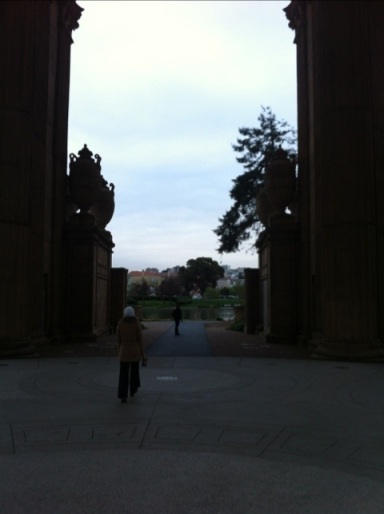Explainers live a good life. Before getting to hang out with excited kids and adults and share our love for the exploration of science, we get a one-hour long training, every morning, on a variety of different topics. Occasionally, we get together and just talk about stuff, or discuss some topic of interest. Recently, our training consisted of generating questions that we wanted answered about evolution. A lot of interesting stuff originated, but this is not what this post is about.
It seems like, these days, you can’t talk about evolution without someone bringing up the “controversy”. You know what I’m talking about. Intelligent design. And, inevitably, someone mentions that “isn’t it true that evolution is just a theory”, as if this justified proposing as an alternative something “just as valid”, like intelligent design. Problem is, that statement is misleading (I’ll let you decide whether that’s intentional or not on the part of proponents of ID), and it originates from the fact that “theory” has one meaning in science, and often a different meaning in common parlance. A lot of people seem to think that a theory is just a scientist’s opinion, and if it turns out to be true, it could become a fact. The difference between an opinion, a fact, and a theory is a pet peeve of mine, and so here goes my rant.
The best definition of the difference between those three elements that I have ever heard is from Michael Fanselow, a professor at UCLA who teaches learning theory. (He’s also a shockingly smart guy. Being in graduate school is a very humbling experience in that you’re constantly confronted with people who are very much smarter than you.) So I’m going to steal appropriate it:
An opinion is just an idea, with no formal basis, not based on hard facts but just on how you feel about something. Some examples: “pancakes are yummy”; “Tom Waits rocks”; “Jar-Jar Binks sucks”; you get the gist: those are all opinions.
A fact is a single piece of information that is true. Apple falls when dropped: fact. Rock falls when dropped: fact. Book falls when dropped: fact. And so forth.
A theory is a way to organize a lot of facts and make predictions. Tidy up those words a little bit and you get: a theory is a systematic set of assumptions that makes predictions and organizes facts. A theory doesn’t necessarily have to be right or wrong; it has to be useful, because it organizes a lot of facts, and it has to be testable, i.e. its predictions must be able to be confirmed or disproved.
The theory of gravity, for example, is such because it explains lots and lots of facts. This is much simpler than having to keep stating single instances.
Therefore, a theory can (no pun intended) evolve. In fact, the theory of gravity is the perfect example of this process. Galileo first found out that all objects on Earth accelerate at the same speed when falling. Newton picked up on that and figured out that the force that was making stuff fall on Earth was the same that was keeping planets in orbit around the sun. His Law of Universal Gravitation came down to a neat little equation that predicted the orbits of all the planets. In fact, it predicted the existence of a new planet that nobody had yet seen, Neptune. Later on, Neptune was found exactly where Newton’s law had predicted it should be. You can see how that has been useful: its predictions have been confirmed, and we’ve all gained a planet.
But then, scientists found a discrepancy in Mercury’s orbit that could not be accounted for by Newton’s law. They started looking for more stuff in the solar system that could “fix it”, but couldn’t find any. Predictions were not confirmed. The theory was “wrong”. Then along came Albert Einstein with his General Relativity theory, which accounted for the Mercury discrepancy. Turns out, Einstein was right, Newton was wrong: out went Universal Gravitation, in came General Relativity. However, a theory’s value is also in its usefulness. General relativity is a bitch to compute; Newton’s theory is easy-peasy. Unless a staggering amount of precision is required, scientists still use Newtonian gravitational law to calculate the movement of planets and celestial bodies.
Evolution is a theory because it explains an astonishing number of facts and has some seriously kick-ass predictive power. (For a fascinating example of the predictive power of evolutionary theory, read about how it predicted the existence and unique social structure of the naked mole-rat!) In fact, evolution does nothing short of providing an explanation for the diversity of life on Earth. The theory of evolution is not an opinion, it is the best way science has to explain a lot of facts about life on Earth. If and when a better theory will come along, it will supplant evolution, no hard feelings.
Intelligent design, on the other hand, is not a theory. It doesn’t systematically organize facts, it doesn’t explain anything, and most importantly, it does not make testable predictions. Therefore, as far a science is concerned, it is just an opinion. Putting the two on the same plane and saying we need to “teach the controversy” is preposterous.
It would be like you trying to explain the chemical reactions between baking soda and buttermilk that make pancakes fluffy, and someone coming along refuting your explanation by saying: “but I like French toast better!”, then demanding that, in all your future lectures on the chemistry of acid/base reactions, you also mention that French toast is a perfectly valid alternative to pancakes. Most people would not see a controversy there. They would see one person trying to provide an explanation for a physical phenomenon, and the other hijacking the issue by using an unrelated emotional argument.
But this, of course, is just my opinion.









